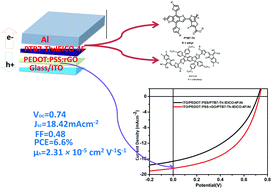Application of reduced graphene oxide as the hole transport layer in organic solar cells synthesized from waste dry cells using the electrochemical exfoliation method†
Abstract
The hole transport layer (HTL) plays an important role in improving the efficiency and stability of organic solar cells (OSCs). In this study, waste dry cell batteries were used as the source of graphite (G) to synthesize graphene oxide (GO) by the electrochemical exfoliation method. Reduced graphene oxide (rGO) was synthesized from electrochemically exfoliated graphene oxide (GO) using the modified Hummers’ method. UV-Vis absorption spectroscopy, X-ray diffraction, Fourier transform infrared spectroscopy, and conductivity meter were used to characterize G, GO, and rGO. The HTL thin film of Glass/ITO, Glass/ITO/PEDOT:PSS, Glass/ITO/rGO, Glass/ITO/PEDOT:PSS:rGO surface morphologies were assessed for roughness using atomic force microscopy. The active layer was spin-coated from the blend solution of PTB7-Th:IEICO-4F. The HTL of the OSCs fabricated from PEDOT:PSS and the composite PEDOT:PSS:rGO achieved the highest power conversion efficiency (PCE) of 5.07–6.55%, short-circuit current density (JSC) of 16.61% to 18.42 mA cm−2, and fill factor (FF) of 42–48%, which was consistent with the enhanced hole mobility of 1.67 × 10−5 to 2.31 × 10−5 cm2 V−1 S−1, respectively. These findings indicate that the solution-processed PEDOT:PSS:rGO hole transport material is a promising interfacial material for use in OSCs.



 Please wait while we load your content...
Please wait while we load your content...